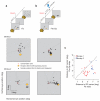Saccadic eye movements evoked by optogenetic activation of primate V1
- PMID: 22941109
- PMCID: PMC3458167
- DOI: 10.1038/nn.3210
Saccadic eye movements evoked by optogenetic activation of primate V1
Abstract
Optogenetics has advanced our understanding of the neural basis of simple behaviors in rodents and small animals. In primates, however, for which more sophisticated behavioral assays exist, optogenetic manipulations of behavior have been unsuccessful. We found that monkeys reliably shifted their gaze toward the receptive field of optically driven channelrhodopsin-2-expressing neurons of the primary visual cortex. This result establishes optogenetics as a viable tool for the causal analysis of behavior in primate brain.
Figures



References
-
- Aravanis AM, et al. An optical neural interface: in vivo control of rodent motor cortex with integrated fiberoptic and optogenetic technology. Journal of neural engineering. 2007;4:S143–156. - PubMed
Publication types
MeSH terms
Substances
Grants and funding
LinkOut - more resources
Full Text Sources
Other Literature Sources

